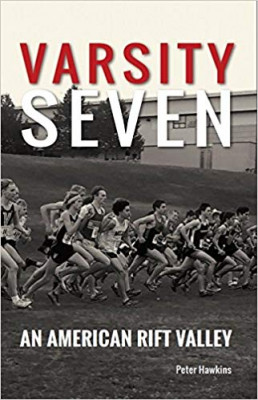Book Review: “Varsity Seven” Shares Some Cool Gerry Lindgren Stories, But Is Far Too Long For Even The Die-Hard Running Fan
By Jonathan Gault
October 10, 2018
When it comes to high school running, few U.S. cities can rival Spokane, Washington. The Greater Spokane League consists of 10 schools; five of them have competed at Nike Cross Nationals since its inception in 2004, with three different schools reaching the podium during that span. Before that came the Mead High School dynasty of the early 1990s, including the famed 1993 squad that boasted three future Foot Locker finalists. And back in the 1960s there was Gerry Lindgren, one of the all-time great high school runners, who placed ninth at the 1964 Olympics a few months after graduating from Rogers High School.
“Spokane is pound for pound one of the strongest areas for raising competitive boys cross country teams on the west coast and the nation,” writes Peter Hawkins. “The volunteers, athletes, coaches families collectively make Spokane a Rift Valley of American Distance Running.”
Hawkins, a 2005 graduate of Ferris High School in Spokane, takes up the challenge of documenting the city’s rich running history. The result is Varsity Seven: An American Rift Valley.
 Support LRC and purchase here.
Support LRC and purchase here.
Each chapter is dedicated to a person who influenced the Spokane running scene, from Lindgren to Pat Tyson (architect of the Mead dynasty and now the coach at Gonzaga University) to 1976 Olympic marathoner Don Kardong, who established the long-running Bloomsday race while working as an elementary school teacher in Spokane and competing for Club Northwest.
Those early chapters are the book’s strength. In particular, the Lindgren stuff stands out as a reminder of just how good this guy was. In 1964, he lowered the national indoor two-mile record by a staggering 43 seconds, taking it from 9:23 to 8:40, where it would stay until Edward Cheserek broke it 49 years later. Later that year, he took on the best runners from the Soviet Union and beat them in front of 50,000 fans at the Los Angeles Coliseum and took down eventual 10,000-meter gold medalist Billy Mills at the Olympic Trials only to be derailed by a bum ankle in Tokyo. He did all this as a scrawny 18-year-old. Gerry Lindgren was good.
The details in the Lindgren chapter are terrific, particularly the account of the first time Lindgren broke the two-mile record at an indoor meet in San Francisco, where Lindgren took the race out in 59.7 for the first 400 yards and dusted a field that included a 16-year-old Jim Ryun. Hawkins also shares an anecdote about another Spokane runner, Rick Riley. As Lindgren crushed records, Riley’s father would drive his silver 1964 GTO down to the local track and turn on the radio so Riley could listen to Lindgren’s races and envision them playing out on the empty oval in front of him. Two years later, Riley set a national outdoor record of his own, running 8:48 in 1966.
Despite those educational and entertaining early chapters, Varsity Seven suffers from a number of problems. At 452 pages, the book is far too long, and Hawkins dedicates 172 pages solely to the exploits of one family: his own. Hawkins tries to use the story of his family — he is one of seven siblings, all of whom ran cross country at Ferris — to trace the history of the GSL in the 1990s and 2000s, but rather than weaving the two together, he focuses on the personal. That would be okay if the personal anecdotes he shares were compelling, but for the most part, they are not. We hear plenty about his siblings’ paper routes and their jobs at McDonald’s and not enough about how Ferris placed second at NXN in 2009 or how North Central built its 2008 NXN championship team. Even for a Spokane running diehard, there is simply too much about the Hawkins family to keep the reader’s interest for 452 pages.
This, and many of the book’s other issues, could have been solved with stronger editing. Hawkins writes most of the book in third person — including the chapters about his siblings, which makes it awkward when he writes “Peter” instead of “I” — before switching to first person for the chapter he writes about himself. There are dozens and dozens of typos, including some egregious ones such as the use of “tenant” instead of “tenet” and the misidentification of legendary York High School coach Joe Newton as “Joe Newman.” And Hawkins writes most of the book in passive voice, which can make Varsity Seven painful to read at times.
Hawkins admits that Varsity Seven was a labor of love — his admiration for men like Lindgren, Kardon, Tyson and other Spokane legends is abundantly clear, and for the most part, he does justice to their stories. If you want to learn more about those men, then Varsity Seven is worth your time. But unless your last name is Hawkins, you can shut the book halfway through.
Support LRC and purchase Varsity Seven here.
More: Other book reviews by LetsRun.com can be found here.
